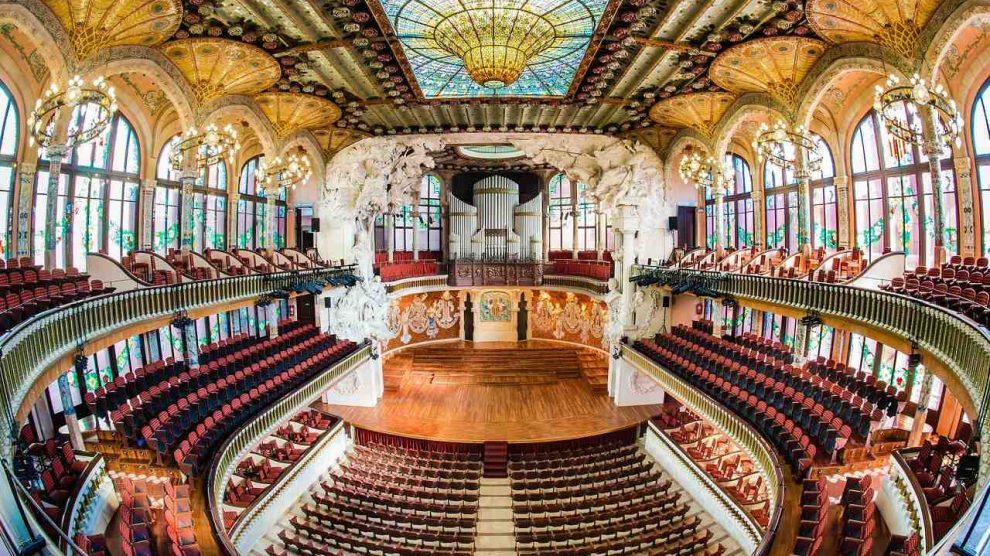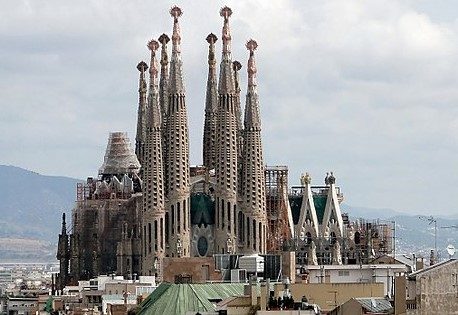
Without question, Barcelona is one of the world’s greatest tourist destinations. Travelers should be aware of caution signs, however.
The city is so well-publicized as a glamorous destination that some of its businesses seem to take visitors for granted and treat them brusquely. First, though, let’s concentrate on what’s great in Barcelona.
This is a city where architecture is the most conspicuous attraction. Not only is it the hometown of Antoni 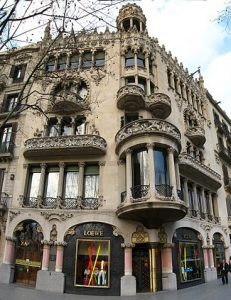 Gaudi; Barcelona is filled with buildings that emulate that master in their embellishments. When you walk down the broad main boulevard, or when you ride a tourist bus around the city, you can’t help but be impressed with the ornate balconies and balustrades.
Gaudi; Barcelona is filled with buildings that emulate that master in their embellishments. When you walk down the broad main boulevard, or when you ride a tourist bus around the city, you can’t help but be impressed with the ornate balconies and balustrades.
Many of Barcelona’s buildings at intersections have a diagonal edge known as a chamfered corner. This gives crossroads an open feel, and provides diagonal surfaces for terraces.
On the right, Domènech house:
Gaudi favored natural and organic materials and he took them to surrealistic extremes. The facade of his Casa Batlló has multicolored tiles and balconies adorned with skulls and bones. This building, designed as a home for an aristocrat, is open to the public and the imaginative, futuristic interior is well worth your time and money.
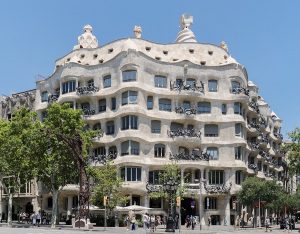 Diagonally across the street, on a corner, is Gaudi’s La Pedrera with undulating walls and forged iron balconies (pictured on the left.) Its exterior is more attractive than the interior. One of Gaudi’s earliest buildings is the palace residence of the wealthy Güell family. It’s a jewel that should not be missed. The sober exterior masks idiosyncratic interior designs, including the family’s living room with cathedral ceilings and an organ. Detailed ornamentation is more tradition-based than what you’ll see in later Gaudi buildings.
Diagonally across the street, on a corner, is Gaudi’s La Pedrera with undulating walls and forged iron balconies (pictured on the left.) Its exterior is more attractive than the interior. One of Gaudi’s earliest buildings is the palace residence of the wealthy Güell family. It’s a jewel that should not be missed. The sober exterior masks idiosyncratic interior designs, including the family’s living room with cathedral ceilings and an organ. Detailed ornamentation is more tradition-based than what you’ll see in later Gaudi buildings.
Gaudí, a leader of Catalan culture, spent over forty years designing the Temple of the Sagrada Familia and it was in progress when he died in 1926. (Pictured at the top of this story.) It’s still unfinished today; completion is promised around 2030. Part fanciful and part overwhelming, the temple has eight immense spires rising 560 feet. The inspiration is Gothic, but Gaudi added Art Nouveau splashes plus ahead-of-his-time modernism. At the tops of ornate columns are brightly-colored turtles.
The Sagrada Familia is one of the most popular tourist attractions in the world. Its interior is so huge, though, that you don’t feel crowded once you get inside. If you get inside. Thousands of people are turned away each day. You must make advance reservations. Once inside, you can stay as long as you like. Exploring its intricate adornments or just sitting in reverence of its immensity, we enjoyed a tranquil visit observing the changing patterns of light filtering through the stained glass windows. In an expression of Gaudi’s populist views, all unemployed people in Spain are entitled to free admission on Wednesday afternoons.
On the right, Gaudi’s Batlló house: 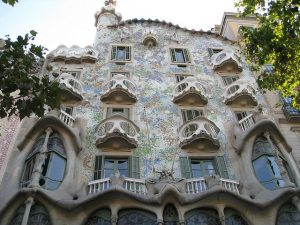
The city also is the home of Frank Gehry’s Fish, which is a gigantic sculpture built for the Barcelona World’s Fair in 1992. Facing the beach, its stainless exterior glimmers like a fish moving under water. Rising along the same street is a comic-book Pop Art sculpture by Roy Lichtenstein. Adjoining that is a giant lobster sculpture by Spanish artist Javier Mariscal.
Along Barcelona’s boulevards are many statues, most of them in classic style, of mythological figures and historic heroes — a contrast to Gaudi, Gehry and Lichtenstein.
Modern architecture stands near ancient. Mies Van de Rohe, a giant of 20th century architecture, is represented by a pavilion he designed for the German government for the Barcelona World’s Fair in 1929. To epitomize the democratic and culturally progressive Weimar German republic, he erected a simple structure but used exotic materials such as travertine, onyx and chrome. The columns of the Temple of Augustus, from the Roman Empire, remain intact and are preserved in a courtyard. A palace from the Visigoth period has been reconstructed and is the home of an interesting historical museum.
One of Barcelona’s best views is from the mountainside museum of Joan Miró’s art, and a cable car descends from there to the harbor and its many seafood restaurants.
Barcelona’s opera house, the Gran Teatro del Liceu, has a conventional exterior on a main commercial street, like New York’s original Metropolitan Opera at 39th & Broadway. Inside, however, is a beautiful interior with an imposing staircase rising from the lobby. In its neighborhood are some charming small restaurants frequented by the cultural community and young fashionistas. But their number is dwarfed by a huge amount of tourist traps.
This brings us back to the topic of what’s lacking. Let’s consider some cases:
Admission to the Barcelona Cathedral, a 19th century edifice on one of the main plazas, is included on the Barcelona Card, which we had. Yet the guard barred our entry unless we paid an additional fee. A Spanish lady after us merely wanted to pray but was turned away because she didn’t have enough money.
Admission to the Palau de la Musica Catalana also is included on the Barcelona Card. This is an elaborate 1908 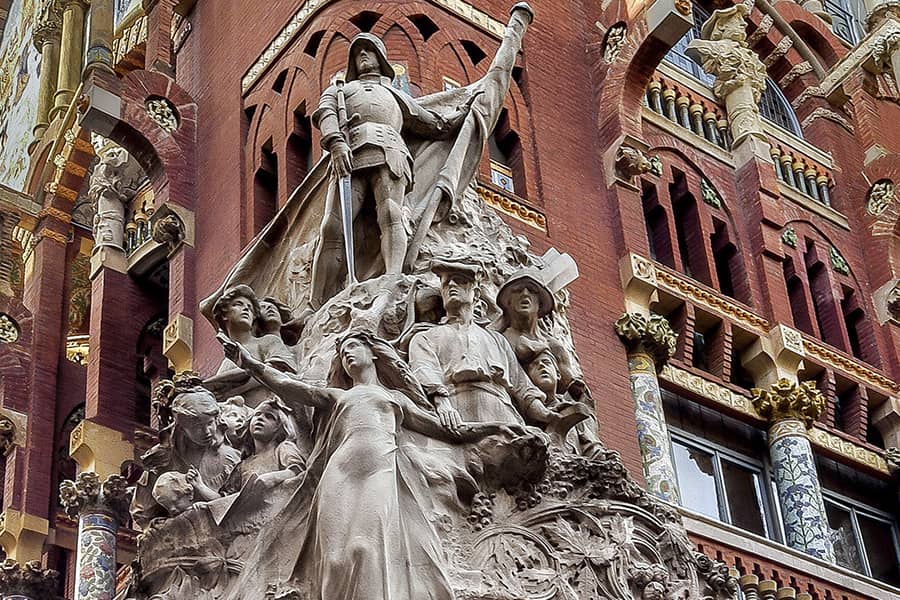 building by architect Lluis Domènech i Montaner. His ornate style seems influenced by Gaudi with fabulous ornamentation (see photos of the outside here, and the inside below.) But the house manager denied us, saying they had a concert later that night. On the other hand, the management of Barcelona’s famed opera house was totally hospitable.
The concierge at our apparently-respectable hotel recommended a place “where all the local people dine.” But it tuned out to be a commercialized place targeting foreign travelers and service was assembly-line.
That’s not what we come to Barcelona for. Thank goodness that an opera patron steered us to Cañete, an inconspicuous bar located behind the opera house that serves everything from tapas (such as pork jowls with smoked herring, or veal sweetbreads with prawns) to steak with foie gras, or deboned suckling Iberian pig. Waiters are jovial and the food is delicious. This experience leaves us with very warm feelings about Barcelona.
building by architect Lluis Domènech i Montaner. His ornate style seems influenced by Gaudi with fabulous ornamentation (see photos of the outside here, and the inside below.) But the house manager denied us, saying they had a concert later that night. On the other hand, the management of Barcelona’s famed opera house was totally hospitable.
The concierge at our apparently-respectable hotel recommended a place “where all the local people dine.” But it tuned out to be a commercialized place targeting foreign travelers and service was assembly-line.
That’s not what we come to Barcelona for. Thank goodness that an opera patron steered us to Cañete, an inconspicuous bar located behind the opera house that serves everything from tapas (such as pork jowls with smoked herring, or veal sweetbreads with prawns) to steak with foie gras, or deboned suckling Iberian pig. Waiters are jovial and the food is delicious. This experience leaves us with very warm feelings about Barcelona.
Inside the Palace of Catalan Music:
